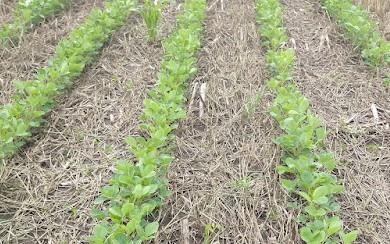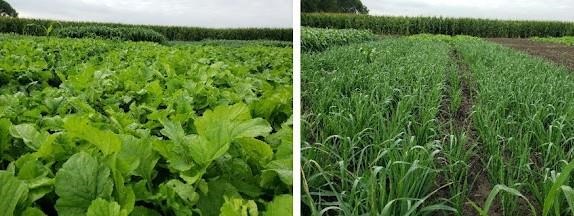By Eric Yu and Debalin Sarangi et.al
When planting cover crops in the fall, it's important to identify your goals for using a cover crop in rotation. Your expected outcomes will influence the cover crop species selection, seeding rate, planting date, and termination timing.

Photo 1. Cereal rye cover crop (plant residue in between the
soybean rows) planted in late September and terminated in
early May of the following year at SWROC near Lamberton, MN
Cover crops may increase soil organic matter, improve soil health, reduce erosion, suppress weed growth, scavenge residual nitrogen, and conserve soil moisture. Although many cover crop species provide these benefits, some species or mixes are better than others depending on the geographic location and objectives (Table 1). This article mostly focuses on cereal rye and oats, two fall-planted grass cover crop options for Minnesota.
Table 1. Types of cover crops and their benefits.
| Cover crop type | Examples | Benefits |
|---|
| Legumes | | |
| Winter annuals | Crimson clover (Trifolium incarnatum L.)
Field pea (Pisum sativum L.)
Hairy vetch (Vicia villosa R.)
Subterranean clover (Trifolium subterranean L.) | Legumes are able to fix nitrogen from the atmosphere and add it to the soil, attract beneficial insects, help control erosion, and add organic matter to soils. |
| Summer annuals | Cowpea (Vigna unguiculata L.)
Lablab bean (Lablab purpureus L.)
Sunn hemp (Crotalaria juncea L.)
Velvet bean (Mucuna pruriens L.) |
Biennial and
perennials | Red clover (Trifolium pratense L.)
Sweet clover (Melilotus officinalis L.)
White clover (Trifolium repens L.) |
| Grasses | Annual ryegrass (Lolium multiflorum L.)
Cereal rye (Secale cereale L.)
Millet (Pennisetum glaucum L.)
Oats (Avena sativa L.)
Sudangrass (Sorghum × drummondii L.)
Triticale (×Triticosecale Wittmack) | Grasses have fibrous and extensive root systems, which are useful for scavenging nutrients and reducing erosion. They produce a large amount of residue that adds organic matter to the soil and suppresses weed germination and growth. |
| Others | Brassicas including:
Oilseed radish (Raphanus sativus L.)
Rapeseed (Brassica napus L.)
Buckwheat (Fagopyrum esculentum M.) | Brassicas may function as biofumigants, suppressing soil pests including root pathogens and plant-parasitic nematodes. |
Types of fall-planted cover crops
There are mainly two types of fall-planted cover crops: Winter-killed and winter-hardy cover crops. For both types, maximizing growth and biomass is beneficial by planting as early as possible in the fall.
Winter-killed cover crops
The dead plant matter of winter-killed cover crops creates a layer of residue that can help protect soil from erosion and increase soil organic matter. The density of the residue layer will depend on how much biomass was produced from planting to the first hard frost. The winter-killed cover crop doesn’t influence the field preparation and cash crop planting in the spring.

Photo 2. Forage radish (left) and oat (right) planted in July at SWROC near Lamberton
Oats are a great winter-killed cover crop option in Minnesota. Oats are a cool-weather crop that will be able to tolerate light frosts but will be killed at temperatures below 5oF. Oats can be seeded in the fall reliably until September 12 in southern MN and September 7 in northern MN, although they can be seeded for several more weeks with the risk of establishment due to a freeze or low soil moisture. The recommended seeding rate is 30 to 50 lbs. per acre when drilled, 40 to 70 lbs per acre when broadcast, or 53 to 88 lbs. per acre when aerial seeded.
Winter-hardy cover crops
Winter-hardy cover crops will initially grow through the fall and establish root systems that prevent soil erosion. Once temperature drops, winter-hardy cover crops will become dormant until the following spring.
Cereal rye is a great winter-hardy cover crop option in Minnesota. It is relatively inexpensive, easy to establish, and easily available seeds. Cereal rye can withstand Minnesota winter and resume growth in the spring. In Minnesota, cereal rye can be seeded from mid-August to early November. Research conducted in SW Minnesota shows that the fall and spring growth of cereal rye is optimized when cereal rye is seeded by mid-September. Spring growth is less when planting is delayed into October. The recommended seeding rate is from 55 to 100 lbs. per acre when drilled, 77 to 140 lbs. per acre when broadcast, and 95 to 175 when aerial seeded.
Recommendations for successful germination and establishment
- Ensure good seed-to-soil contact. We have found the most consistent establishment when cover crops are drilled at a proper depth. Sufficient soil moisture ensures good germination and establishment in the fall.
- Seed as early as possible after harvesting the main crop in the fall or interseed the cover crop into corn or soybean once the crops are close to or have reached physiological maturity and the crop canopy is starting to open up.
Source : umn.edu